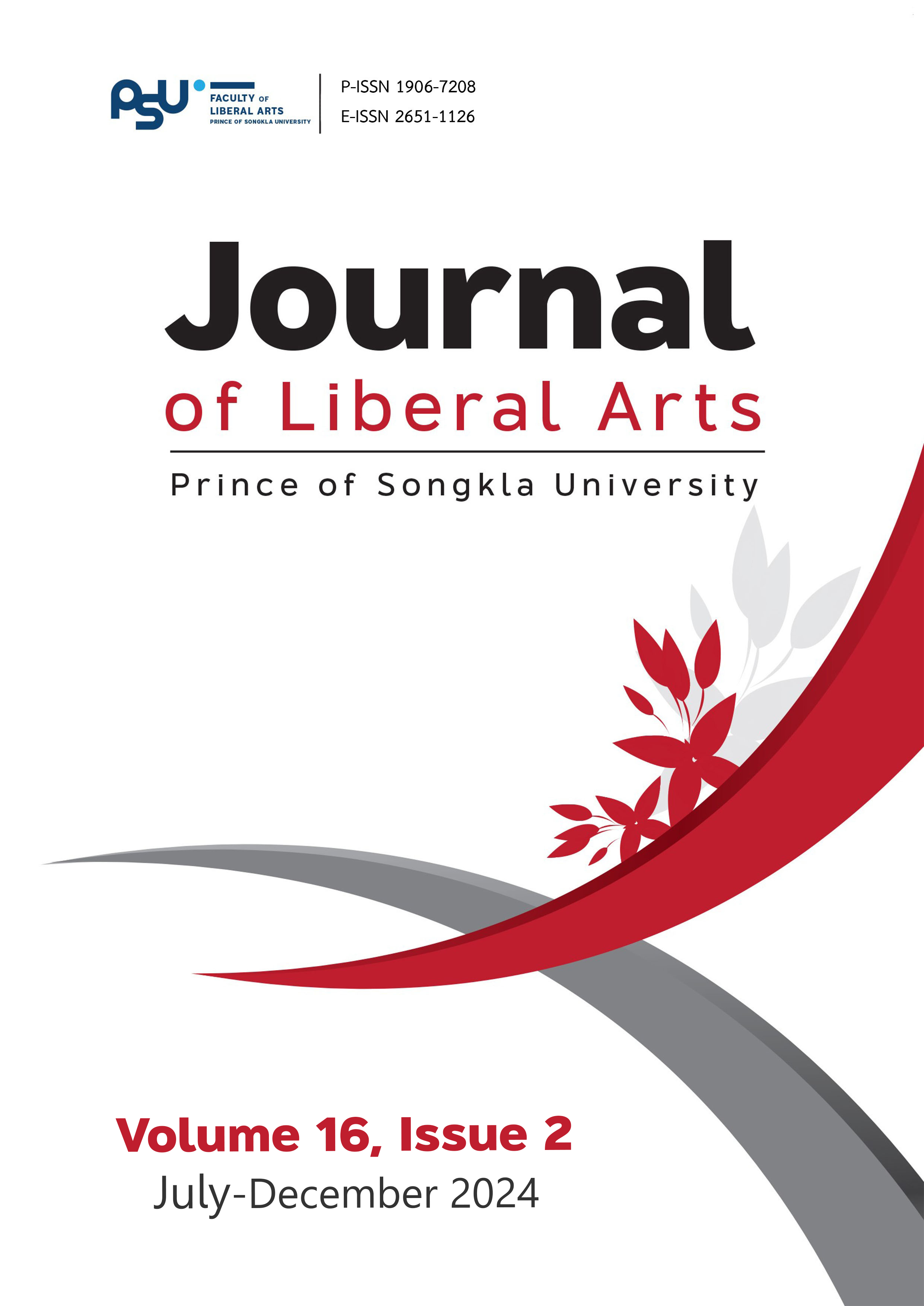การวิเคราะห์โครงสร้างประโยค ในงานเขียนระดับย่อหน้าภาษาอังกฤษของนักเรียนไทยชั้นประถมศึกษา
DOI:
https://doi.org/10.14456/jlapsu.2024.11คำสำคัญ:
โครงสร้างประโยค , งานเขียนระดับย่อหน้าภาษาอังกฤษ , นักเรียนชั้นประถมศึกษา , คลังคำศัพท์ของผู้เรียนที่เรียนภาษาอังกฤษในฐานะเป็นภาษาต่างประเทศบทคัดย่อ
บทความวิจัยนี้มีวัตถุประสงค์ เพื่อศึกษาโครงสร้างประโยคในงานเขียนระดับย่อหน้าของนักเรียนชั้นประถมศึกษาปีที่ 6 และเพื่อเปรียบเทียบความแตกต่างของโครงสร้างประโยคระหว่างกลุ่มของนักเรียนที่มีระดับความสามารถทางภาษาอังกฤษที่แตกต่างกัน การวิจัยในครั้งนี้เป็นการวิจัยเชิงปริมาณ โดยศึกษากับนักเรียนระดับชั้นประถมศึกษาปีที่ 6 จำนวน 203 คน ที่โรงเรียนประถมศึกษาแห่งหนึ่งในภาคตะวันออกเฉียงเหนือของประเทศไทย เครื่องมือที่ใช้ในการวิจัยคือ ข้อสอบวัดระดับความสามารถทางภาษาอังกฤษ และงานเขียนระดับย่อหน้าเชิงบรรยาย สถิติที่ใช้ในการวิเคราะห์ข้อมูล ได้แก่ ความถี่ ค่าเฉลี่ย ส่วนเบี่ยงเบนมาตรฐาน และการทดสอบไคสแควร์ เพื่อเปรียบเทียบความแตกต่างของค่าเฉลี่ยระหว่างนักเรียนที่มีระดับความสามารถทางภาษาอังกฤษทั้ง 3 กลุ่ม ผลการวิจัยพบว่า นักเรียนชั้นประถมศึกษาปีที่ 6 ใช้โครงสร้าง coordinate main clauses มากที่สุด โดยโครงสร้างประโยคแบบ quotation ไม่ปรากฏในงานเขียนระดับย่อหน้าของนักเรียน เมื่อพิจารณาความยาวของงานเขียน พบว่า ความยาวเฉลี่ยของอนุประโยค คือ 6.8 ความยาวเฉลี่ยของประโยค คือ 16.24 และความยาวของ T-unit คือ 11.15 ผลการทดสอบไคสแควร์แสดงให้เห็นว่า การใช้โครงสร้างประโยค correlative clauses, relative clauses, complement clauses, adverbial clauses และความยาวเฉลี่ยของอนุประโยคของนักเรียนชั้นประถมศึกษาปีที่ 6 ที่มีระดับความสามารถทางภาษาต่างกันมีความแตกต่างอย่างมีนัยสำคัญที่ระดับ 0.05 ผลการวิจัยสรุปได้ว่า ระดับความสามารถทางภาษาอังกฤษสามารถมีผลต่อการใช้โครงสร้างประโยคในระดับย่อหน้า ทั้งนี้ ผลการวิจัยนับเป็นประโยชน์ ในด้านการสอนและการพัฒนาสื่อการสอนทักษะเขียนภาษาอังกฤษในฐานะภาษาต่างประเทศอีกด้วย
References
Ahmad, S. A. (2016). Importance of English communication skills. International Journal of Applied Research, 2(3), 478-480.
Aprilia, P.K. (2021). Analysis on sentence patterns in Thai students’ essay. Jurnal Penelitian, Pendidikan, dan Pembelajaran, 16(17).
Berninger, V. W., Nagy, W., & Beers, S. (2011). Child writers’ construction and reconstruction of single sentences and construction of multi-sentence texts: contributions of syntax and transcription to translation. Reading & Writing, 24(2), 151–182. https://doi.org/10.1007/s11145-010-9262-y
Boonyarattanasoontorn, P. (2017). An investigation of Thai students’ English language writing difficulties and their use of writing strategies. Journal of Advanced Research in Social Sciences and Humanities, 2(2), 111-118.
Cahyono, B. Y. (2016). Indonesian students’ writing proficiency and their ability in using complex sentences. International Journal on Studies in English Language and Literature (IJSELL), 4(9), 22-32. http://dx.doi.org/10.20431/2347-3134.0409004
Cambridge University Press. (n.d.). English Language Assessment - Young Learners. https://www.cambridgeenglish.org/test-your-english/young-learners
Chuenchaichon, Y. (2018). An analysis of syntactic complexity used in essay writing produced by EFL writers. Journal of Humanities, Naresuan University, 16(2), 1-20.
Cooper, T. C. (1976). Measuring written syntactic patterns of second language learners of German. The Journal of Educational Research, 69(5), 176–183. https://doi.org/10.1080/00220671.1976.10884868
Ernawati, A. (2014). An analysis types of sentences used by the students’ Essay writing at the third semester of IAIN Tulungagung in the 2013/2014 academic years. Tulungagung: IAIN Tulungagung, 1-11.
Genç, R. (2017). The importance of communication in sustainability & sustainable strategies. Procedia Manufacturing, 8(1), 511 – 516. https://doi.org/10.1016/j.promfg.2017.02.065
Hunt, K.W. (1966). Sentence Structures Used by Superior Students in Grade Four and Twelve and by Superior Adults. Florida State University; Tallahassee.
Hunt, K. W. (1970). Syntactic maturity in schoolchildren and adults. Monographs of the Society for Research in Child Development, 35(1). https://doi.org/10.2307/1165818
Huy, N. T. (2015). Problems affecting learning writing skill of grade 11 at Thong Linh high school. Asian Journal of Educational Research, 3(2), 53-69
Hwang, H., Jung, H., & Kim, H. (2020). Effects of written versus spoken production modalities on syntactic complexity measures in beginning-level child EFL learners. The Modern Language Journal, 104(1), 267-283.
Jiang, J., Bi, P., & Liu, H. (2019). Syntactic complexity development in the writings of EFL learners: Insights from a dependency syntactically-annotated corpus. Journal of Second Language Writing, 46, 1-12. https://doi.org/10.1016/j.jslw.2019.100666
Khemanuwong, T., Muangnakin, P., Phairot, E., & Kho, S. H. (2020). Difficulties in writing English language research paper: The experience of Thai NNES postgraduate students. 2020 Panyapiwat International Conference on Social Science and Management, 3(2), 62-78.
Kraus, S. (1957). A comparison of three methods of teaching sentence structure. The English Journal, 46(5), 275–281. https://doi.org/10.2307/809628
Lestari, N. R. (2017). Error Analysis of Sentence Structure in Writing Personal Letter Made by Kalasan 1 Senior High School Students Class Xi IPS 1 in the Academic Year of 2015/2016. Islamic University of Indonesia.
Lu, X. (2010). Automatic analysis of syntactic complexity in second language writing. International Journal of Corpus Linguistics, 15(4), 474 –496.
Martínez, A. C. L. (2018). Analysis of syntactic complexity in secondary education EFL writers at different proficiency levels. Assessing Writing, 35, 1–11. https://doi.org/10.1016/j.asw.2017.11.002
Ministry of Education. (2008). The Basic Education Core Curriculum B.E. 2551 (A.D., 2008), Bangkok: Ministry of Education.
Noom-ura, S. (2013). English-teaching problems in Thailand and Thai teachers’ professional development needs. English Language Teaching, 6(11), 139-147.
Office of the Basic Education Commission. (2014). The Guideline of English Teaching Management based on The Common European Framework of Reference for Languages (CEFR). Bangkok: Ministry of Education.
Ortega, L. (2003). Syntactic complexity measures and their relationship to L2 proficiency: A research synthesis of college-level L2 writing. Applied Linguistics, 24(4), 492-518.
Piyapasuntra, S. (2009). The development of syntactic complexity in Thai children’s narratives. Manusya, 12(3), 58–74. https://doi.org/10.1163/26659077-01203005
Promsupa, P., Varasarin, P., & Brudhiprabha, P. (2017). An analysis of grammatical errors in English writing of Thai university students. HRD Journal, 8(1), 93-104.
Putrayasa, I. D., Ramendra, D. P., & Aryana, I. B. P. M. (2018). The type of sentence in the essays of grade vi elementary school students in Bali province: A syntactic study. Advances in Social Science, Education and Humanities Research, 166(1), 121-124.
Richard-Amato, P. A. (1996). Making it happen: Interaction in the second language classroom: From theory to practice (2nd ed.). New York, NY: Longman.
Sojisirikul, P., & Vasuvat, S. (2014). Analysis of sentence structures through translation for a reading task. Journal of Studies in the English Language, 9.
Thongyoi, K., & Poonpon, K. (2020). Phrasal complexity measures as predictors of EFL university students’ English academic writing proficiency. rEFLections, 27(1), 44–61. https://doi.org/10.61508/refl.v27i1.241750
Yu, X. (2021). A study on the role of sentence structure analysis in English learning. OAlib, 08(09), 1–14. https://doi.org/10.4236/oalib.1107859
Yulianti, S., Nuraeni, S., & Parmawati, A. (2019). Improving students’ writing skill using brainwriting strategy. Project (Professional Journal of English Education), 2(5), 714-721. https://doi.org/10.22460/project.v2i5.p714-721
Downloads
เผยแพร่แล้ว
How to Cite
ฉบับ
บท
License
Copyright (c) 2024 Kanchaya Thongkum, Kornwipa Poonpon

This work is licensed under a Creative Commons Attribution-NonCommercial-NoDerivatives 4.0 International License.
ลิขสิทธิ์บทความเป็นของผู้เขียน แต่วารสารศิลปศาสตร์ มหาวิทยาลัยสงขลานครินทร์ ขอสงวนสิทธิ์ในการเป็นผู้ตีพิมพ์เผยแพร่เป็นครั้งแรก




